Tempura is one of the most famous dishes of Japan. Deep fried seafood and vegetables coated in tempura batter are renowned for the delicate crispy coating that is quite different to other deep fried foods around the world.
With the right batter mix and a few tips (cooking video is below the recipe), tempura is surprisingly easy to make at home.
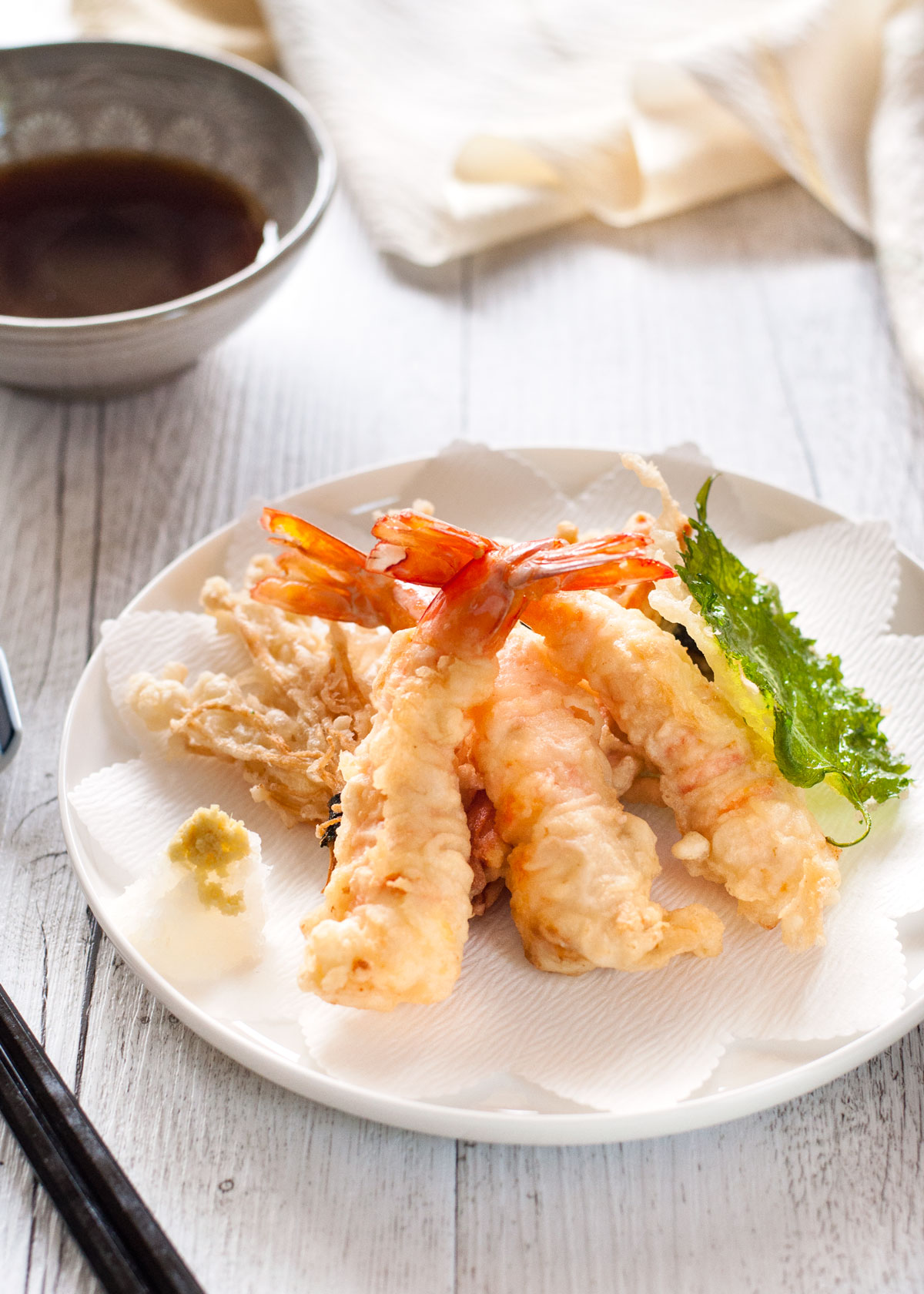
A Signature Dish in Japanese Cuisine – Tempura
Tempura (天ぷら or 天婦羅) used to be an everyday food and sold at food stands. I am talking about 18th to mid-19th century, when Japanese were wearing kimonos and men were carrying swords. Later, tempura shops started opening and they became specialty tempura restaurants.
Nowadays, I would say that tempura is considered to be a fine-dining dish. When you have kaiseki ryori, a Japanese-style full-course dinner, tempura is almost always included in the menu.
It will take years of highly skilled training to make tempura like the tempura chefs do, and you may not be able to make them look like the professionals’ (I certainly can’t!), but you can still make delicious tempura at home. I will show you how, but first, let me explain a few key things which will help you make good tempura.
Ingredients
In my recipe, I used prawns, eggplant, enoki mushrooms, carrot and shiso (紫蘇 or しそ, Japanese perilla) leaves because I happened to have these vegetables in my fridge.
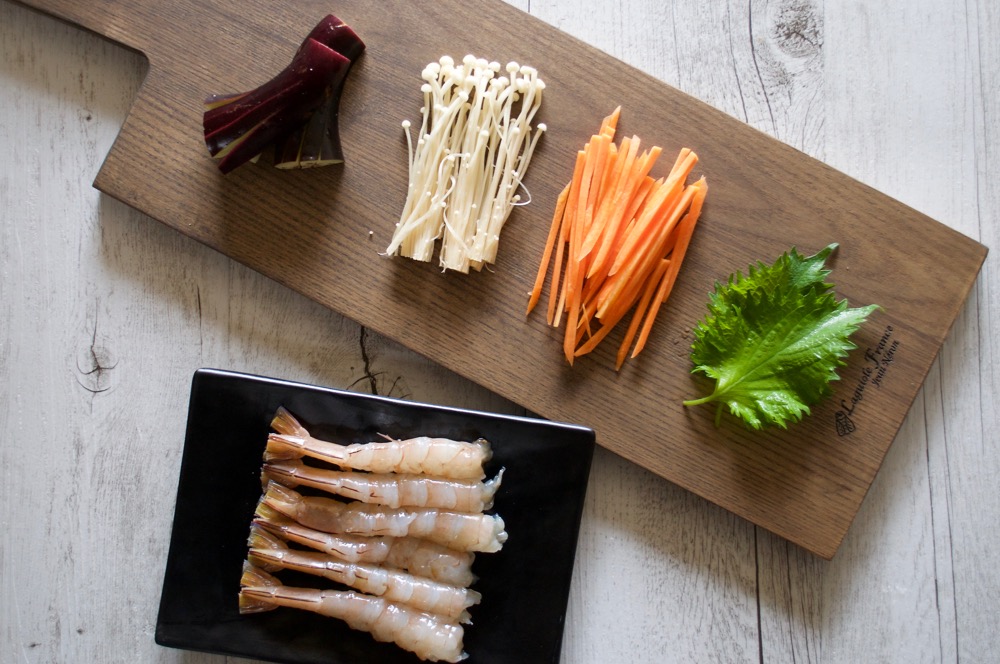
But tempura can be made with many combinations of seafood and vegetables. See the typical tempura ingredients below.
Seafood – prawn (shrimp), whiting, squid, scallop, conger eel
Vegetables – pumpkin, carrot, eggplant, sweet potato, burdock, lotus root, shiitake mushrooms, shiso (Japanese perilla) leaves
Of those, prawn (shrimp) is no doubt the most popular ingredient. Oily fish and flaky fish are not suitable. Among the Japanese people, the most popular vegetable ingredients are pumpkin and sweet potato. But you may like other vegetables. I like eggplant, as it melts in your mouth.
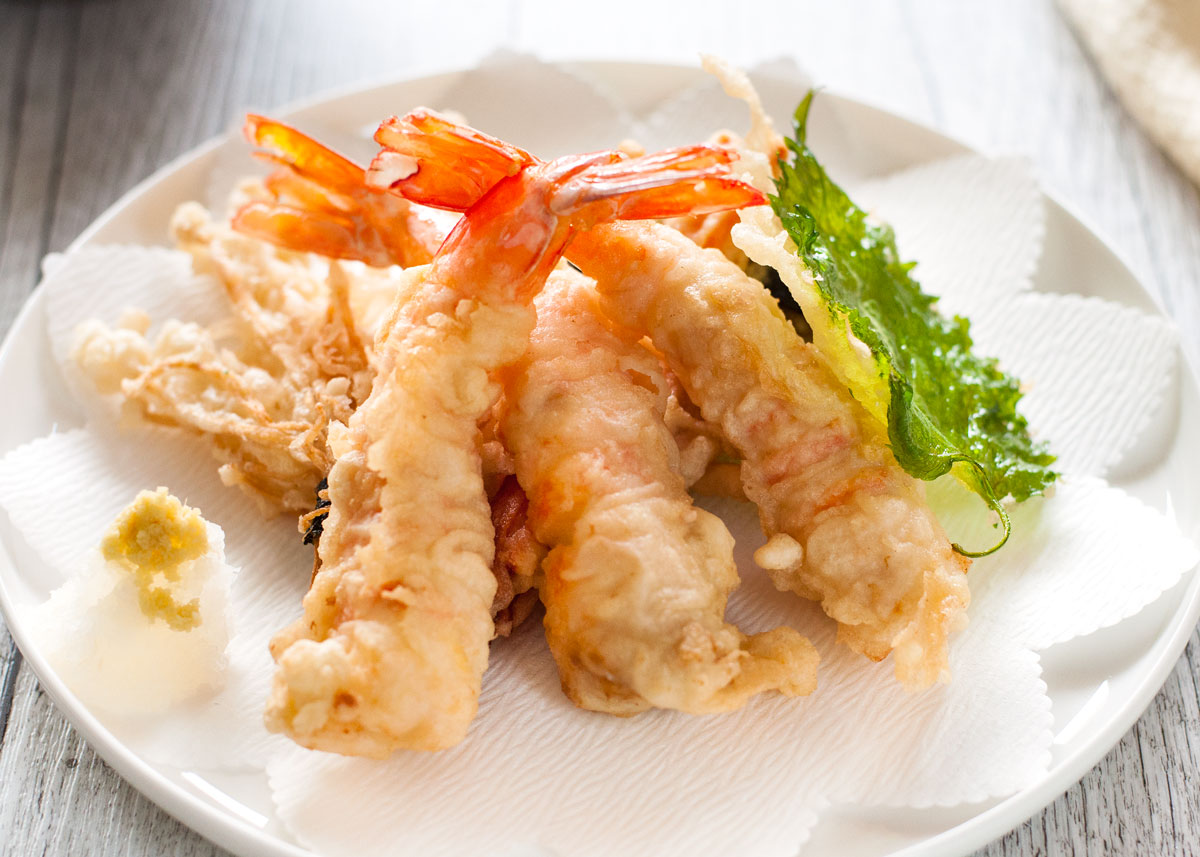
I sometimes make tempura with only vegetables called shojin-age (精進揚げ). The name came from the Buddhist monks’ vegetarian cooking, called shojin ryori (精進料理). If you make shojin-age and serve with dipping sauce made with vegetarian dashi stock such as konbu dashi (please refer to Varieties of Dashi Stock), it will become a vegetarian dish.
All the ingredients should be patted dry with paper towel to remove excess water. You could dust ingredients such as prawns (shrimps), eggplants with flour before dipping them in the batter. This will achieve consistent coating of batter. But I often skip dusting step. Root vegetables such as carrot and burdock should be julienned. In the case of shiso leaves, you put batter on one side only (the back of the leaf), so that you can show the bright green colour of the leaf.
Tempura Batter
Many of the tempura batter recipes on the internet use bicarb soda or baking powder in pursuit of making the batter crunchy when fried. Traditional batter is just a mixture of flour, egg and water.
The two secrets to a crunchy tempura are:
- Do not overmix the batter. When you mix the batter too much, it activates wheat gluten and it makes the batter heavy and dough like when fried; and
- Keep it super cold so that it will slow down the activation of gluten. Also the batter scatters when fried which creates the light bubbly surface that tempura is known for.
So here are the key things to making crunchy batter:
- Keep the batter ingredients cold – chill all ingredients, even flour, in the fridge overnight if possible.
- Mix chilled water and egg first, then add flour.
- Do not mix the batter too much – just draw the number 8 in the batter a several times and don’t worry about powdery lumps of flour remaining in the batter.
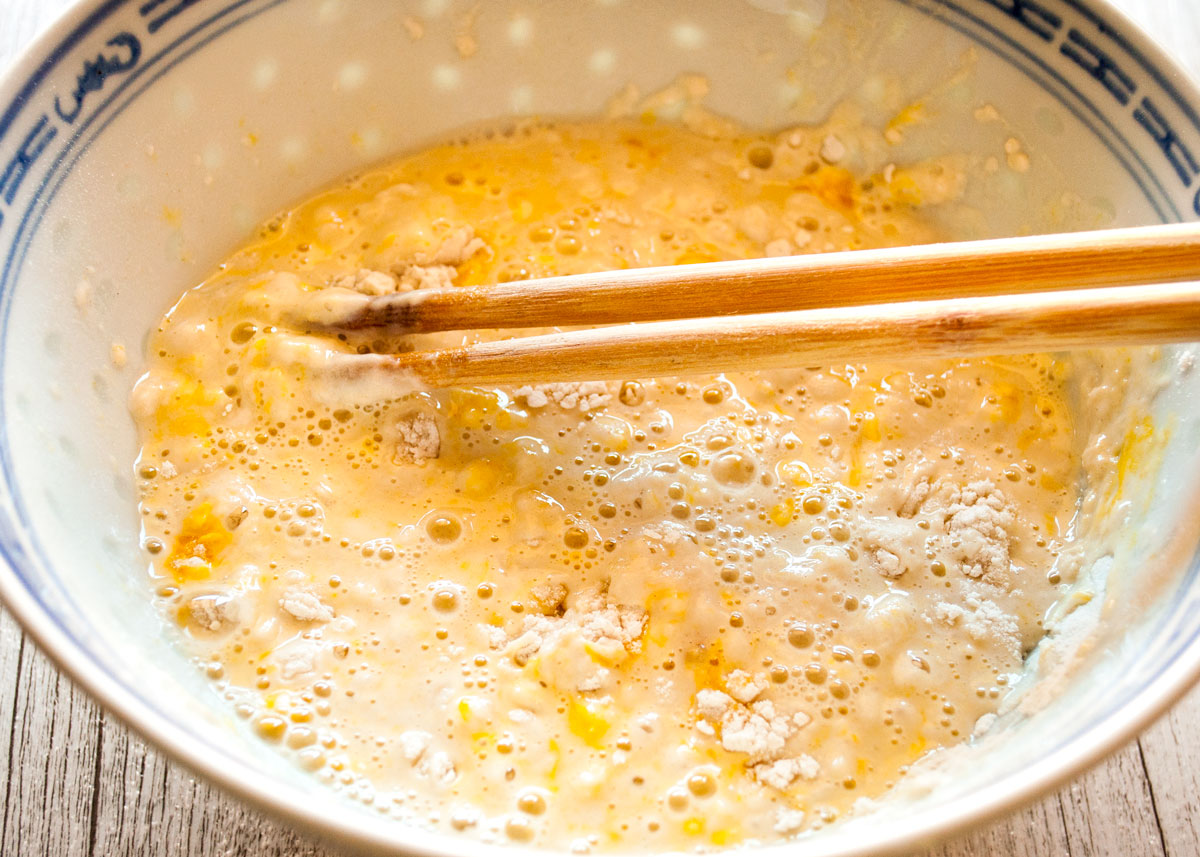
Frying
The most important thing is the temperature of the oil. The ideal temperature depends on the ingredients. Follow these frying tips:
- Vegetables should be deep fried at 170C (325F), while seafood should be at 180C (350F).
- The depth of the oil should be no less than 3cm (1¼”).
- Use a deep frypan, or a saucepan with a flat bottom, so that the temperature of the oil will be even.
- The oil should not be overcrowded with ingredients.
Fry vegetables first, then seafood.
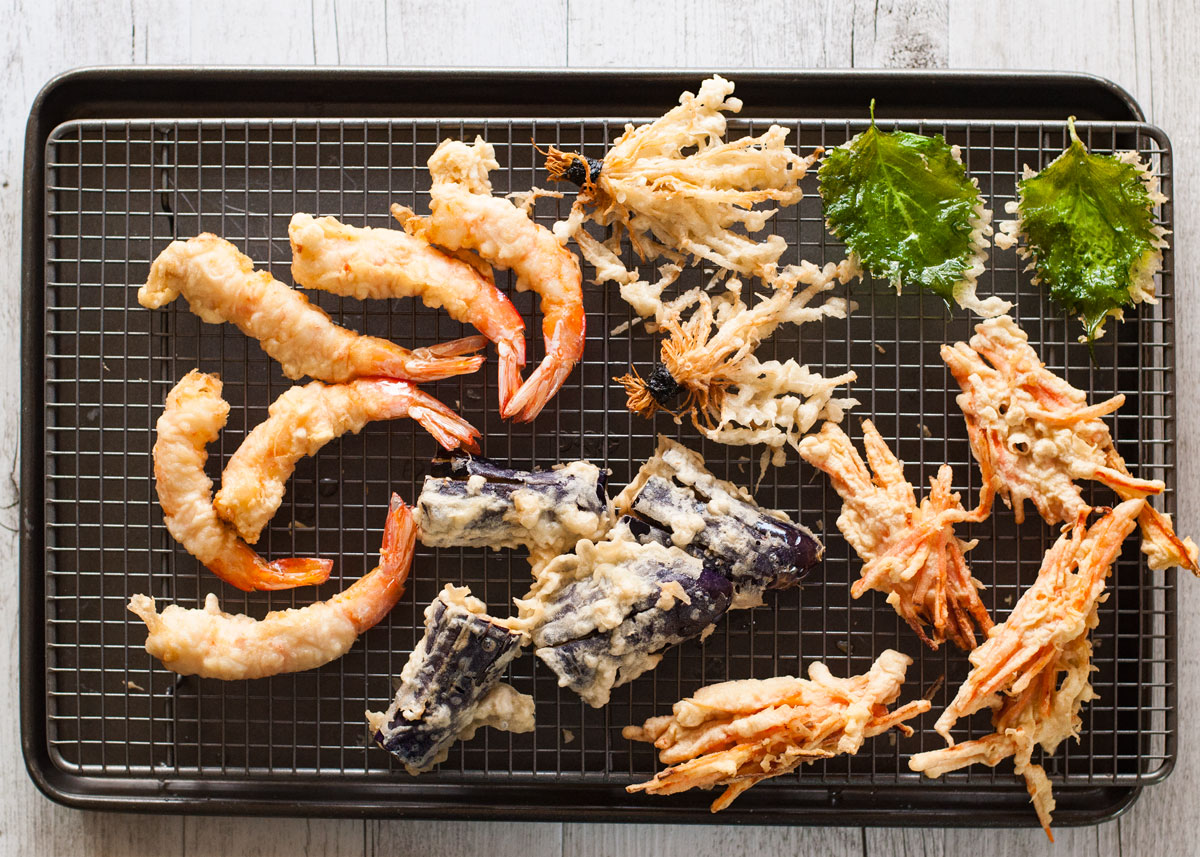
Dipping Sauce
Tempura dipping sauce is quite simple to make. It is just a mixture of dashi stock (please refer to Home Style Japanese Dashi Stock), mirin and soy sauce. The portion of these ingredients is 4:1:1 respectively. If you prefer stronger flavour of the sauce, you could make the ratio up to 3:1:1. The tempura should be eaten while hot and the sauce should be served warm.
When you order a tempura dish, you will notice that a small amount of grated daikon (white radish) and grated ginger are placed next to the tempura (see the first photo of this post for example). They are meant to be added to the tempura dipping sauce like the photo below.
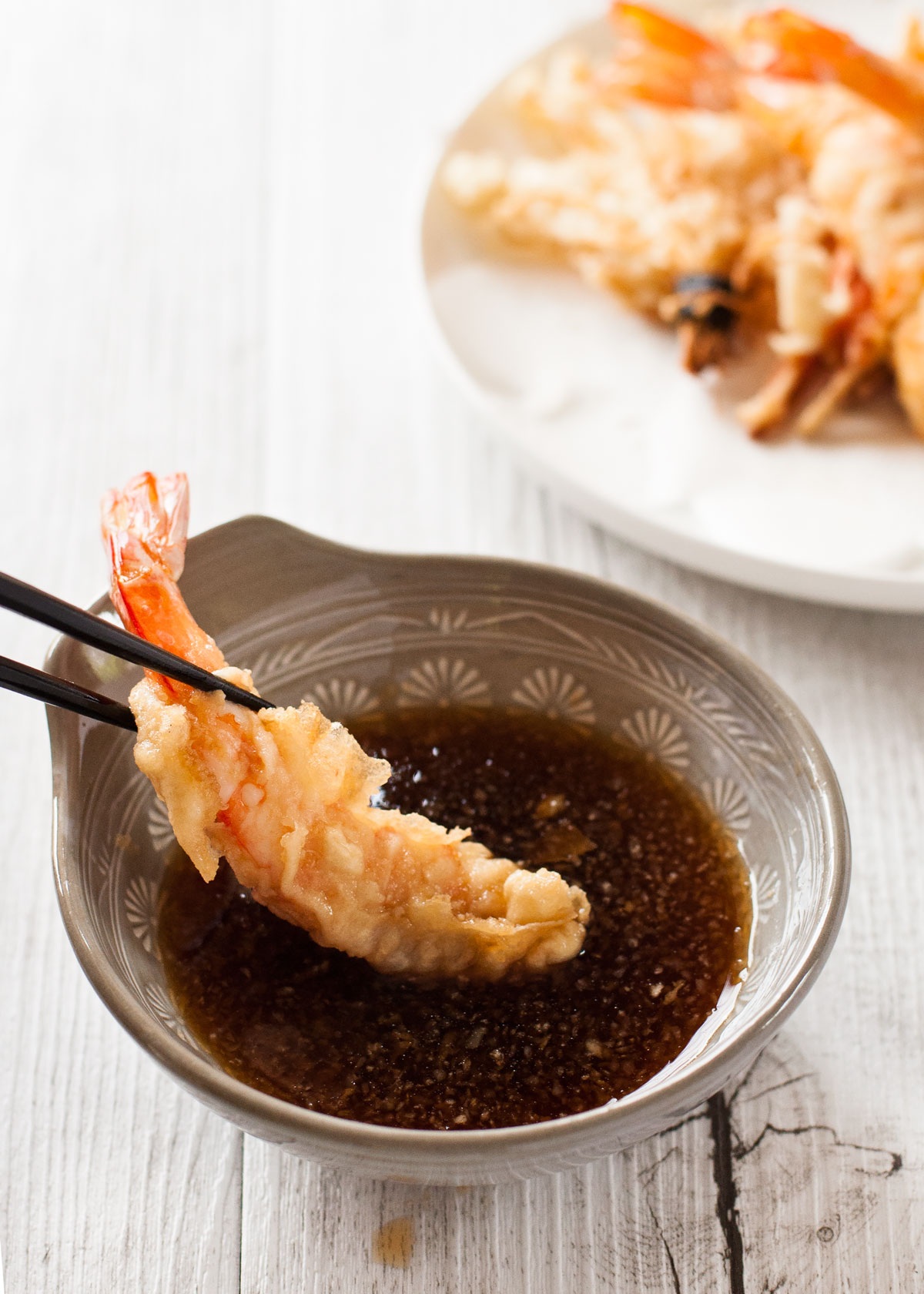
This recipe is quite long, but only because I have tried to explain the preparation of each ingredient and the frying method in detail. Once you understand it, it’s actually pretty simple and fast to cook.
Why don’t you make tempura at home instead of eating out at restaurants?
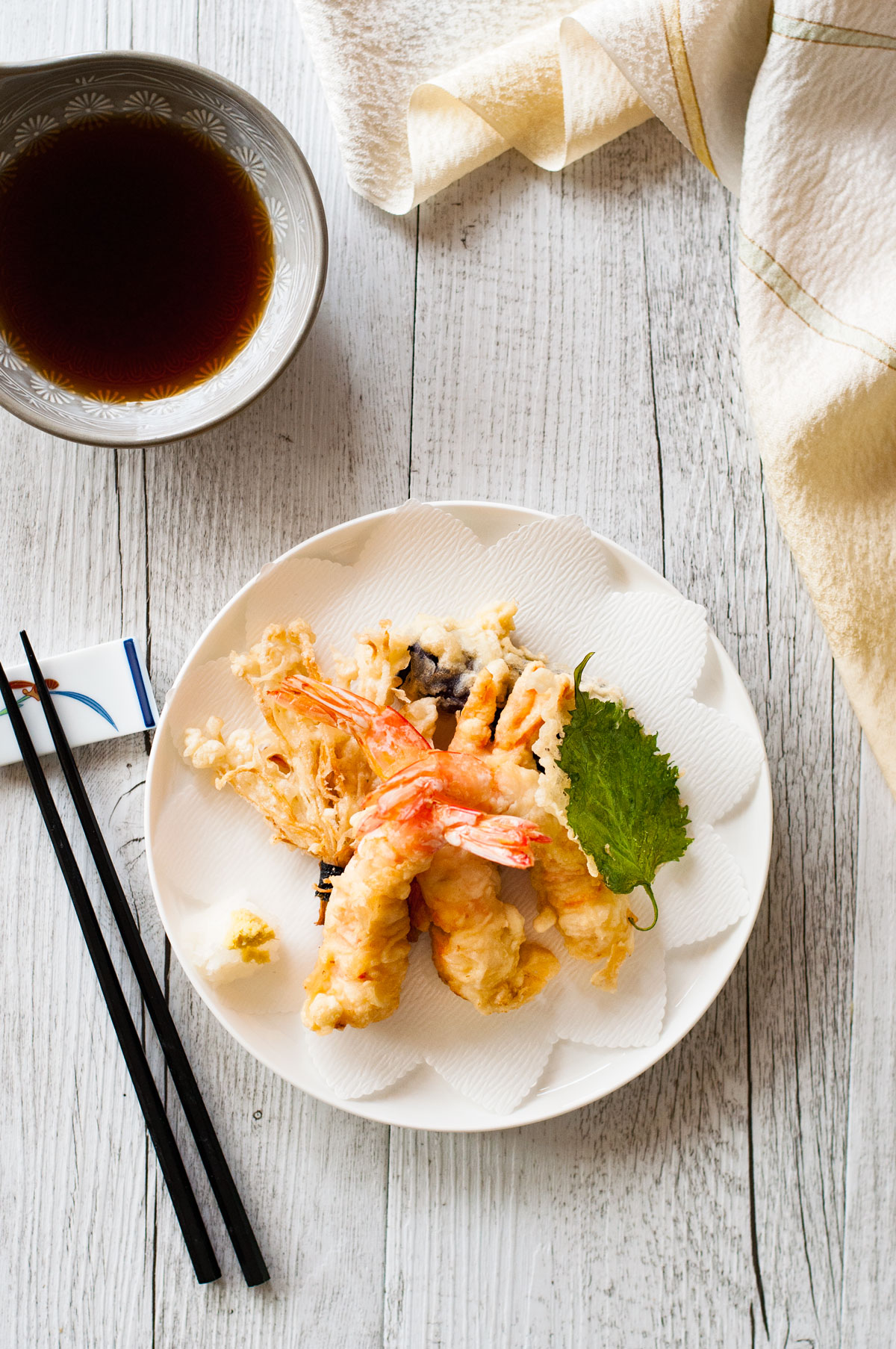
Yumiko
![]()
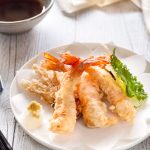
- 180ml (6 oz) dashi stock
- 3 tbsp mirin
- 3 tbsp soy sauce
- 4 tbsp grated daikon (white radish)
- 1 tsp grated ginger
- 1 small eggplant (about 80g (2.8oz), Note 2)
- 50g (2 oz) enoki mushrooms (Note 3)
- 4 strips of 5cm x 1cm (2 x 2/5”) yaki nori (roasted seaweed) (Note 3)
- 50g (2 oz) carrot
- 4 shiso leaves (Japanese perilla, Note 4)
- 12 prawns (shrimps) (Note 5)
- Oil for deep frying (Note 6)
- 1 egg
- 200ml (6.5 oz) cold water
- 240ml (8.1 oz) flour
-
Add dashi stock and mirin to a small saucepan over high heat and bring to a boil.
-
Add soy sauce and as soon as it starts boiling, turn the heat off and put aside until required.
-
Eggplant: Discard the head of the eggplant, then cut it lengthwise in half. Halve each piece again by cutting perpendicularly to the first cut. Place them skin-side up on a cutting board and slice each piece into lengths of 5mm (¼”) width, keeping the narrow end of the eggplant piece intact for about 1.5cm (½”), so that it will become like a fan.
-
Enoki mushrooms: Divide the enoki mushrooms into 4 bunches. Take a strip of yaki nori and wrap it around the root end of a bunch to keep the stems together. Wet the end of the yaki nori strip to glue it.
-
Carrots: Julienne the carrots into matchsticks of 5cm (2”) length.
-
Prawns (shrimps): Remove the head, peel and devein prawns (Note 8), leaving on the last segment and the tail. Make 3 slits at equal intervals on the underside of each prawn to stop them from curling when cooked.
-
Add the egg and cold water to a bowl or measuring cup, and mix well until there is no cluster of egg white.
-
Add two thirds each of the egg mixture and the flour to a separate bowl, and gently mix by drawing the number 8 several times, leaving powdery lumps of flour. Keep the remaining egg mixture and flour in the fridge, as they will be added later (Note 9).
-
Fill a deep frypan or pot with oil up to a minimum depth of 3cm (1¼”) and heat the oil to 170C (335F). Drop a tiny amount of batter onto the surface, and if it hardly touches the bottom and returns to the surface, it is at the right temperature.
-
Cook the same ingredients together unless you are serving one person at a time. The order can vary, but prawns should be cooked last. Cook in batches but do not cover more than 30-40% of the surface area of the oil with the tempura. Ingredients should be patted dry before dipping in the batter.
-
Eggplants – dip in the batter to coat the entire eggplant piece, then drop it gently into the oil one by one. Cook for about 45-60 seconds until the eggplant tempura comes to the surface and you can see large bubbles around it. Flip it over and cook for a further 45 seconds or so until the eggplant becomes light when lifted and very lightly browned, then transfer to a wire rack.
-
Enoki mushrooms – hold at the root with a yaki nori strip and dip the enoki in the batter, without letting go so that the yaki nori strip is not coated. Drop it gently into the oil and cook for 10-20 seconds. Flip it over and cook for few seconds. Transfer to a wire rack.
-
Shiso leaves – hold the end of the stem and dip only the back side of the leaf into the batter, then drop the whole leaf into the oil, making sure that the battered side is facing the bottom of the pan. Cook for 5-10 seconds and transfer to a wire rack.
-
Carrots – add all the carrot sticks to the batter. Take about a quarter of them and place on a flat wooden spatula, then slide them into the oil while holding them together. Cook for about 60 seconds until the carrot tempura comes up to the surface and you can see large bubbles around it. Flip it over and cook for a further 45-60 seconds, then transfer to a wire rack.
-
Add remaining egg mixture and flour to the batter and gently mix just like the first time. Try not to mix with the batter left at the bottom of the bowl too much as they are now glutinous.
-
Increase the temperature of the oil to 180C (350F). At this temperature, when you drop a tiny amount of batter it will surface straight away.
-
Hold a prawn by the tail and dip it into the batter, leaving the tail uncoated. Drop it gently into the oil and cook for about 60 seconds, until it comes to the surface and you can see large bubbles around it. Flip it over and cook for a further 45-60 seconds, then transfer to a wire rack.
-
Place one piece each of eggplant, enoki mushroom and carrot tempura onto the plate. Place three prawns tail-side up, then a shiso tempura. Repeat for the other three servings.
-
Take a quarter of daikon per serving and gently squeeze out any water, then place it to the side of the tempura. Add a quarter of the ginger on top of the daikon.
-
Serve immediately with dipping sauce in a small bowl.
1. Please refer to Home Style Japanese Dashi Stock for how to make dashi stock.
The flavour of the dipping sauce is not as strong as in some other recipes. The ratio of dashi stock, mirin and soy sauce is 4:1:1 respectively. You could change this ratio to 3:1:1 if you prefer a stronger flavour.
2. I bought a small eggplant about 12cm (4¾”) long, 4cm (1½”) wide. If you can find shorter eggplants, you can use two and skip the step to halve the length, ie. the second cut in my recipe.
Common eggplant sold in Sydney is rather large, about 15-18cm (6-7”) long, 6-8cm (2½-3”) wide. This is not suitable for preparation as described above. If you can only find a large eggplant, you could simply slice it into 5mm (3/16”) thick bite sizes.
3. You can substitute enoki mushrooms with shiitake if you like. Then you won’t need yaki nori to tie the stems together. In the case of shiitake mushrooms, it will look prettier if you do not cover the entire mushroom cap with the batter, so that the colour will show when fried.
4. Shiso is a Japanese perilla, a herb with a quite distinctive fragrance. It has broad leaves of about 8cm x 6cm (3⅛” x 2⅜”). There are red shiso leaves as well as green shiso leaves, but the green ones are used for tempura. More details can be found in Wikipedia.
You can buy shiso leaves at Japanese grocery stores. You might find perilla leaves in Asian grocery stores or Asian vegetable shops, but they are most likely the Korean perilla leaves, which are larger and quite different from the Japanese perilla.
5. I used medium prawns about 40g (1.5 oz) each before removing head and shell. Any smaller than this would not be recommended. If quite large, you could reduce the number to two per serve and the cooking time would be longer.
6. Use vegetable oil or canola oil. You could also add a small amount of sesame oil to add flavour to the tempura if you like. Professional tempura chefs do mix sesame oil to the frying oil. Olive oil is not suitable.
7. It is extremely important to keep the batter cold. I measured the ingredients and then left them in the fridge overnight, even the flour.
The quantity (volume) of flour required to make the batter is the same as that of the egg mixture (water + egg). That’s why the flour is measured in volume, not in weight in the ingredients list. Depending on the size of the egg, you can adjust the amount of flour. If you are making a smaller quantity, you could just use an egg yolk.
8. If the vein does not come out by pulling it from where the head was, you can use a toothpick to remove the vein by piercing the middle of the back and lifting up the vein gently.
You do not make a slit along the back of the prawn to remove the vein when preparing for tempura.
9. I saved one third of the batter ingredients to be added after the carrots are fried. This is because by the time the carrot sticks are battered, the batter would have activated gluten a lot and become heavy batter, making crisp lightly battered prawn tempura difficult to achieve.
10. There are no rules as to what should be placed where, but when plating, try to give height with the prawns by leaning them against each other. After all, prawns are the king of tempura!
Grated daikon and ginger may be added to the dipping sauce before eating. You don’t have to add these, as it is g even without them.
Alternatively, you could serve all of the tempura on a large plate to share, accompanied by daikon and ginger in a separate bowl, with dipping sauce for individual.
11. To make vegetarian tempura, make it with vegetables and using konbu dashi stock (please refer to Varieties of Dashi Stock) for dipping sauce.
Phew! That’s a long recipe. After reading my recipe, Nagi insisted that I must include a video. I was the cook (of course) and Nagi was the video taker using iPhone. The iPhone allowed her to move around more easily to take a video from different angles at the stove in my kitchen. But the down side was the lack of stability and you will find that the screen is a bit wobbly. Nagi said she got sea sick by staring at the wobbly pictures while editing the entire video to cut down to this short version. Thank you, Nagi, for helping me to make this video!
Thanks for sharing the tempura recipe, I did it and it was so tasty and easy to make, my husband love it!
Hi Alex, I am glad it went well and both of you enjoyed it!
Yumiko, this is such a wonderful, well detailed recipe, thank you for sharing it! Our little family is having cuisines from different countries around the world each week and this week our country is Japan. What a lovely time I am having cooking your magnificent dishes along with soothing Japanese music getting us into such a relaxed mood. I still have your tonkatsu, yakitori and teriyaki chicken to look forward to making. So far it has only been great reviews from a family of extremely fussy eaters!
Hi Miranda, that’s a wonderful idea to try different cuisines every week! A great way to expand your family’s palate as well as understanding of culture of other countries. Well done!
You website and receipes are great and I tried Tempura with vegies, but were as I expected?
I followed strictly, all the steps, cold egg, very cold water for ALLPUPOSE FLOUR, oil hot and vegies also cold.
I wish you could help me before I use my favorite shrimps next time.
I remember many years ago, eating Tempura in Fresno, a small city in California, in a family owned Japanese restaurant. I still remember the vegies very crispy and blown up like a balloon.
Did I make a mistake using All Purpose sulfurizing flour or something else? Should I use flour without any fermenting agent?
Thanks
Hi Steve, if your tempura did not turn up the way you expected, I am sorry. The traditional tempura does not use fermenting agent and the tempura coating, when cooked, does not blow up. If you are interested, visit my daughter, Nagi’s post about Tokyo Guide Top 10 Food and jump to 8. Tempura where you can see the photos of tempura dishes from two restaurants. Their batter is thin. (I know it’s hard to make it as thin and crispy at home!)
Crispness comes from the batter not mixing properly. If batter is mixed too much, it becomes heavy coating. It’s OK to have dry flour bits everywhere in the batter.
Good luck next time!
You mentioned that “if you are making a smaller quantity, you could just use an egg yolk.” If I only use one egg yolk in the recipe, should I only use half the amount of water?
Hi Heathery, it’s rather opposite. The volume of the flour needs to be equal to the volume of the water + egg. If the egg is small, which would be the case if using yolk only, you’d need to increase the water so that the total volume of water + egg yolk becomes the same volume as flour.
love it,thankyou so much for tempura recipe,
kev
Hi Kevin, you are most welcome! Glad you like it.
LOVE the video!
Hi Chris, thank you!
Hello yumiko, I have already tried tempura on other occasions but it has not been as crispy as I expected, I will try your recipe soon.
But I wanted to comment that I have heard that the tempura is more crunchy if you use low protein flour (pastry flour), have you ever tried this trick?
Also, after reading your post, I am curious about how it is supposed to be a tempura made by professionals? I mean, I’ve never had the opportunity to try them.
Finally, if I use shiitake mushrooms, should they be fresh or can I use dry?
Hi Ruth, I have never tried pastry flour. In the traditional method, cold batter makes it crunchy.
The professional use a lot of sesame oil instead of normal oil to start with. They are also very good at dropping batter around the ingredients in the oil to add more batter around it. I have not mastered it yet.
You need to use fresh shiitake mu=shrooms for tempura.
My mother did this process, hana o sakaseru. I’ve played around with it and it definitely adds more crunch to the tempura. My mother used chopsticks dipped into the batter to drizzle additional batter onto the ingredients as they were frying but I’ve also seen it done with hands. Not really difficult. I like using an electric fryer since the oil temperature is maintained better. Please, readers, tempura is not made with cornmeal or panko, but the way it’s listed here.
Thanks Yumiko!
Hi Chieko, thanks for endorsing the recipe!
I went to Japan for my honeymoon and had the best tempura in Odaiba. I miss the food terribly and have yet to find a decent Japanese restaurant near us. This recipe is great, and I cannot wait to try and make some for myself. Thank you so much for sharing your cooking skills and wisdom of the food with us! I so appreciate this.
Hi Nikki, I miss Japanese food, too. I hope you had a great time in Japan.
Have you ever made a GF tempura batter? maybe with rice flour instead of wheat?
No I haven’t.
Because GF flour, I would think that you can make the batter crunchy more easily. I read the article about the comparison of tempura batter using flour vs rice flour on a Japanese website. It says that the flavour is no different, colour of fried tempura batter is lighter and the thickness of batter is thinner with rice flour. I might try one day.